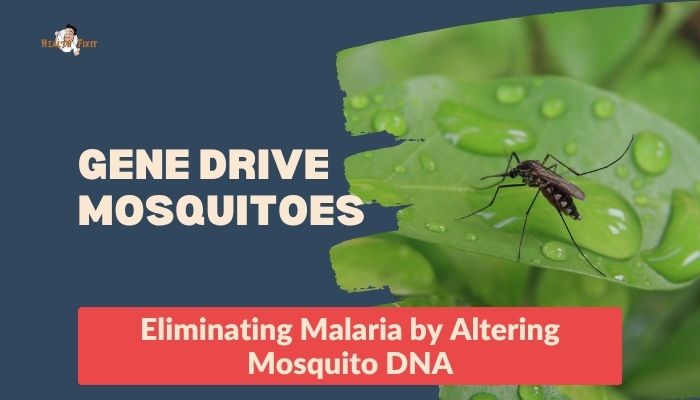Introduction
Malaria remains a global scourge, claiming hundreds of thousands of lives every year—especially in parts of Africa.
Traditional measures, like insecticide-treated nets or drug therapies, have reduced cases but not eliminated the parasite’s grip.
Enter gene drive technology, a genetic engineering approach that can spread specific traits through mosquito populations to block malaria transmission. By altering mosquito DNA, scientists hope to significantly curtail
, or even eradicate, the disease at its source. Yet questions about ecological impact, ethics, and regulatory oversight loom large as gene drives march from the lab toward real-world trials.
The Idea Behind Gene Drives
Mendelian vs. Gene Drive Inheritance
Typically, genes have a 50% chance of passing to offspring under standard Mendelian genetics. Gene drives, however, cheat this system. By copying themselves onto the partner chromosome, they ensure nearly all offspring inherit the engineered trait—potentially spreading swiftly through a wild population.
Target: Mosquito Vectors
For malaria, the main culprits are Anopheles mosquitoes. Researchers design gene drives that either render these vectors sterile or block the parasite’s development inside their body. As these modifications propagate, the disease-carrying population should shrink or lose infective capacity.
CRISPR as the Engine
Modern gene drives often use CRISPR-Cas9, a powerful gene-editing tool, to snip mosquito DNA and insert drive components. With each generation, CRISPR reactivates, ensuring the drive retains near-100% inheritance. This fosters rapid trait spread, a dramatic shift from normal evolutionary timelines.
Strategies for Malaria Control
Population Suppression
One approach is to engineer mosquitoes so that female offspring are sterile or nonexistent—eventually causing the entire local mosquito population to collapse
. Fewer vectors means less malaria transmission. This strategy may require continual gene flow if new, unmodified mosquitoes migrate in.
Population Replacement
Alternatively, scientists might create a drive that makes mosquitoes resistant to malaria infection—no longer able to harbor Plasmodium parasites.
These “replacement” mosquitoes can outcompete wild ones due to the drive, ultimately leading to a predominantly malaria-free vector population without severe population reduction.
Combined Approaches
Some labs test hybrid solutions—reducing vector numbers while simultaneously imposing parasite-blocking mechanisms—maximizing the effect on malaria incidence. The interplay of multiple gene drive traits can accelerate success or mitigate resistance.
Promising Trials and Research
Laboratory Experiments
Gene drive mosquitoes have shown strong potential in contained lab settings. Studies confirm that CRISPR-based drives quickly propagate the desired gene through caged populations. However, lab success doesn’t always translate directly to complex ecosystems.
Semi-Field and Controlled Release
Before full-scale deployment, researchers test gene drive performance in large enclosures mimicking real habitats—like specialized mosquito “greenhouses.”
Early data suggests that gene drive constructs can reduce or nearly eliminate test populations, but long-term stability and potential for resistance must be assessed.
Partnerships and Funding
Organizations like the Bill & Melinda Gates Foundation fund advanced gene drive development. Efforts like Target Malaria coordinate with African research institutes to ensure local communities engage in the decision-making and potential field implementation.
Concerns and Ethical Debates
Ecological Impact
Mosquitoes play roles in local ecosystems—pollinating plants or serving as food for predators. Eliminating or altering a species might inadvertently affect food webs or biodiversity.
Although many argue that certain malaria-causing species have redundant ecological roles, robust environmental impact studies are vital.
Cross-Border Spread
Gene drives unleashed in one region can cross borders via migrating insects, affecting neighboring countries unilaterally. This raises governance questions: which authorities decide on release, and how do we handle international implications?
Community Consent
Populations living amid heavy malaria burden might welcome a gene drive solution, but local knowledge and acceptance remain crucial. Public engagement helps ensure that decisions aren’t top-down, preventing mistrust or accusations of “genetic colonialism.”
Overcoming Hurdles
Resistance to the Drive
Over time, mosquitoes may develop mutations preventing gene drive from copying itself. Designing multiple or “stacked” drive elements can reduce the risk of immediate resistance emergence.
Regulatory and Ethical Frameworks
National and international guidelines must weigh potential benefits (fewer malaria deaths) against ecological unknowns. Approvals from bodies like the WHO or local ministries are needed, guided by consensus-based risk assessments and phased introductions.
Monitoring and Reversibility
Some proposals suggest building “brakes” into drives—like daisy-chain drives—that burn out after several generations or a “reversal drive” to revert changes if unforeseen problems arise
. Ongoing monitoring of mosquito populations ensures early detection of unintended consequences.
Future Outlook
Expanding Beyond Malaria
Gene drives could target other vector-borne diseases (dengue, Zika, chikungunya) or agricultural pests (locusts,
fruit flies). If the malaria model succeeds, we may see broader environmental and public health transformations—though with each new application come fresh ethical debates.
Global Collaboration
Given cross-border ramifications, multinational groups (governments, NGOs, scientists) must collaborate on guidelines and oversight. Transparent communication fosters trust, ensuring local voices shape the approach to releasing or scaling gene drive projects.
Balancing Innovation and Caution
While the ambition to end malaria resonates strongly—saving hundreds of thousands of lives—caution is warranted. Deploying powerful gene drives requires thorough environmental modeling, small-scale field trials, and iterative refinement before large-scale rollouts.
Practical Guidance for Stakeholders
- Engage Communities: Before field releases, ensure local populations understand the technology, potential risks, and benefits.
- Enforce Rigorous Trials: Phased testing in controlled or semi-field environments helps refine drives and address gene drive resistance or ecological ripple effects.
- Adopt Transparent Protocols: Publicly share data and decision processes, from environmental impact studies to ongoing monitoring results.
- Coordinate Internationally: Malaria-endemic regions might cross national boundaries, so collaborative frameworks are vital to align on objectives and safety standards.
Conclusion
Gene drive mosquitoes offer a groundbreaking weapon in the centuries-long battle against malaria. By manipulating mosquito genetics
, scientists hope to either collapse vector populations or transform them into harmless carriers. Though still under development,
the promise of drastically reducing malaria incidence—and sparing countless lives—fuels optimism. Nonetheless,
ecological uncertainties, ethical dilemmas, and global governance remain critical. If approached with careful research
, transparent community engagement, and robust regulatory oversight, gene drive solutions may herald a new era in vector control—one with potential for unparalleled public health impact while preserving the delicate balance of nature.
References
- Esvelt KM, Smidler AL, Catteruccia F, Church GM. Emerging technology: Concerning RNA-guided gene drives for the alteration of wild populations. eLife. 2014;3:e03401.
- Alphey L. Genetic control of mosquitoes. Annu Rev Entomol. 2014;59:205–224.
- Burt A. Heritable strategies for controlling insect vectors of disease. Philos Trans R Soc Lond B Biol Sci. 2014;369(1645):20130432.
- Gantz VM, Bier E. Genome editing and gene drive in mosquitos. ACS Chem Biol. 2016;11(1):21–36.
- National Academies of Sciences, Engineering, and Medicine. Gene Drives on the Horizon: Advancing Science, Navigating Uncertainty, and Aligning Research with Public Values. National Academies Press; 2016.
- Kyrou K, Hammond AM, Galizi R, et al. A CRISPR–Cas9 gene drive targeting doublesex causes complete population suppression in caged Anopheles gambiae mosquitoes. Nat Biotechnol. 2018;36(11):1062–1066.
- Marshall JM, Akbari OS. Can CRISPR-based gene drive be confined in the wild? A question of molecular and global ecology. Curr Opin Insect Sci. 2018;28:59–66.
- Labbé GMC, Scaife S, Morgan SA, Curtis Z. Stakeholder and public attitudes to gene drive. PLoS Negl Trop Dis. 2019;13(4):e0007253.
- Alphey N, et al. The potential gene drive method to control malaria. Trends Parasitol. 2020;36(4):320–326.
- Burt A. Gene drive and the frontiers of mosquito control. Nat Ecol Evol. 2018;2(6):913–914.



